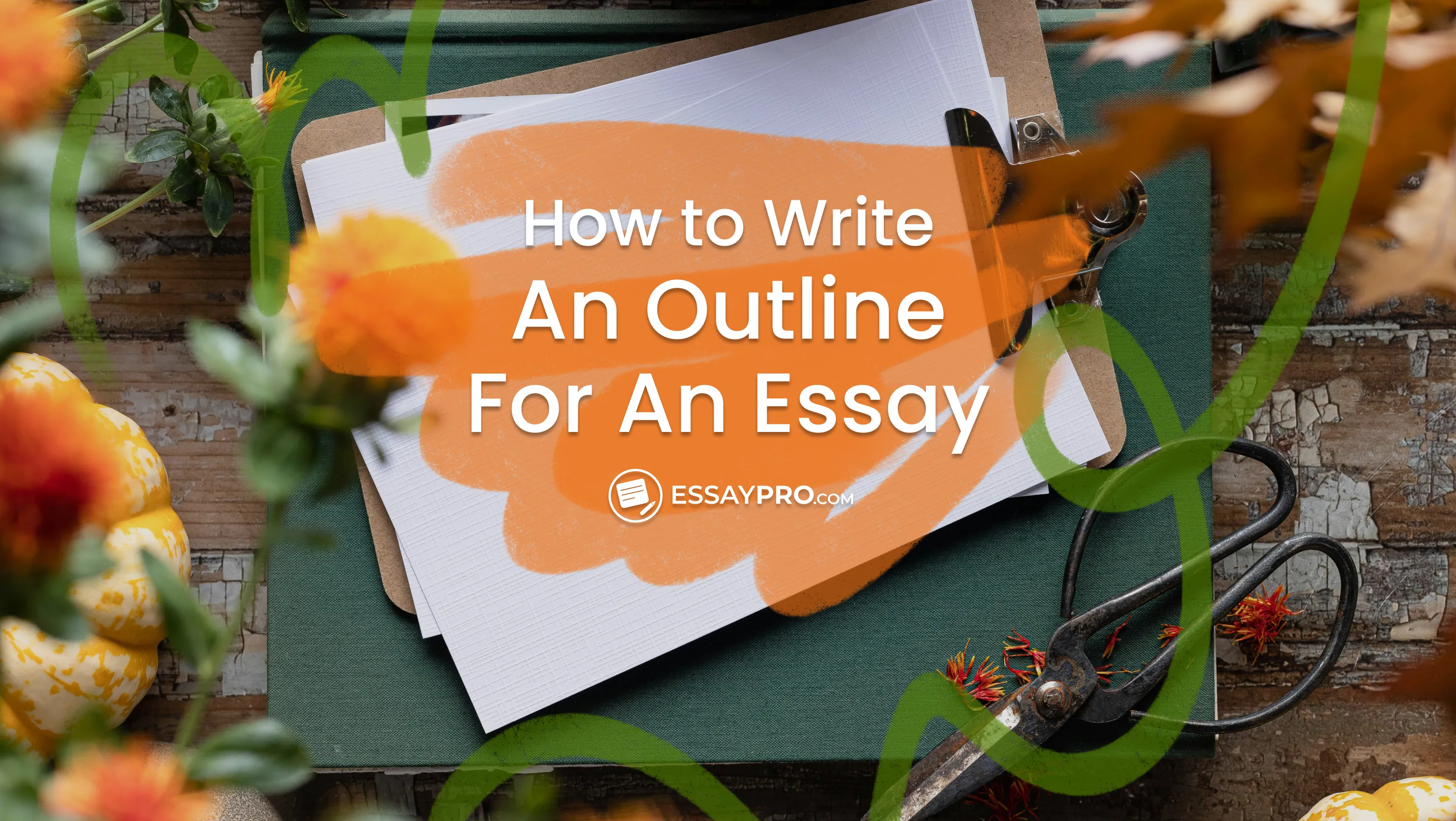An essay outline is a structured plan that shows how your ideas fit together. It's like a blueprint for a house: simple, but strong enough to hold the entire weight of your argument. An outline helps you organize your thoughts, so you can be sure that all parts of your essay support your main argument. Each section in the outline for essay has a specific role, which we will describe in detail later.
What Is an Outline?
An essay outline is a structured plan that organizes an essay's main ideas and supporting points before the writing process begins. If you're trying to figure out how to write an outline for an essay, the best route is to break it down into key sections: the introduction, body paragraphs, and conclusion.
Each section includes brief notes or bullet points detailing what will be covered, helping to ensure a logical of ideas and coherence in the final piece. By providing a clear overview of the essay's structure, essay outlines make the writing process more efficient and help maintain focus on the central argument or thesis.
We’ve also got students posting their outlines for feedback - want yours reviewed too? Head to our writing community.


Parts of an Essay Outline
An essay structure typically includes three main parts: the introduction, body paragraphs, and conclusion. Use a coursework writing service if you’re tasked with a longer paper than a short composition.
Introduction
The introduction is a quick sketch of your opening scene. The opening paragraph starts with a hook, whether you're writing a complex argumentative essay or a simple 5 paragraph essay. When you outline essay, leave short notes about how you plan to draw the reader in. The goal here is just to catch attention, not to write perfect sentences.
The next part is the background information. Mark a concise summary of the details the reader must know before the argument begins. It could be an important term or a quick statistic, enough to orient the reader.
The introduction ends with the thesis statement. If you were just outlining the previous parts, this sentence must be written in full because it's the idea that everything else will prove.
Tips for the Introduction:
- Begin with a hook that catches the reader's interest.
- Add quick background notes that ground the topic.
- Write the thesis in full.
- Cut vagueness early on.
Body Paragraphs
The outline of essay for the body paragraphs can already start mapping out your argument. Each paragraph starts with a topic sentence (a clear claim tied to the thesis), which is better written in full. Beneath it, you should list short notes of supporting evidence: stats, examples, etc. Don't forget to add a line for analysis, an explanation of how the proof connects to your main idea.
Make sure you plan transitions in the essay outline, too. Simple cues like “next point” or “in contrast” help you see the flow before you start writing.
Tips for Body Paragraphs:
- Begin each section with a focused topic sentence.
- Add notes for evidence and short analysis.
- Mark transitions between key ideas.
- Adjust the structure for your essay type.
Conclusion
The conclusion is the final checkpoint of an essay outline. Start mapping this section out by planning how you'll restate your thesis statement, without repetition, based on the evidence you've covered. This small change shows a clearer view of what your essay has already proven.
Next, outline the key points you’ll circle back to. Just a few short notes to show which arguments deserve a final recap. Beneath them, jot a closing thought. Keep in mind, the final paragraph bends with essay type. Persuasive pieces may close with a call to act; analytical outlines often end with insight or implication.
Tips for the Conclusion:
- Restate the thesis with new clarity.
- Highlight the key points briefly.
- Add a line for your final lasting impression.
- Leave new arguments off the page.
Are you a fan of literature? Recommended for reading: The Divine Comedy summary.
How to Outline an Essay in 5 Simple Steps
An outline of an essay simplifies your writing process because it helps you logically organize your ideas. Here are step-by-step instructions for building your outline:

1. Write Your Thesis Statement and Key Points
The first step of writing essay outline is your thesis statement. Once it’s clear, note the main points that will hold it up. Each one should connect directly to your argument, distinct enough to stand alone yet tied to the same thread. As we already advised, you should always write the thesis in full, and only then sketch out the supporting points.
2. Arrange Arguments into Sections
Now shape those points into a structure. All outlines follow the same three parts we discussed in earlier sections. Decide how your key ideas should be laid out when writing an essay outline: chronologically, thematically, or by strength. Place each main point in its own section and check the flow. The goal is movement that feels natural, each idea setting up the next.
Are you pursuing an MBA degree? If yes, use our business essay writing services brough to you by certified experts.
3. Build Out Supporting Evidence
Beneath every main point, add evidence notes: facts, examples, brief quotes, or analysis. Keep them short and purposeful. These details act as stepping stones for your argument, showing what proof belongs where. Seeing them lined up under each section helps balance your outline before you ever start writing.
4. Create an Essay Outline Draft
Pull everything together into a working plan. Note all parts of your introduction and body paragraphs, and end with a strong conclusion that mirrors your central idea. Include just enough to see the logic of your argument at a glance. Now you’re almost done creating an outline for an essay!
5. Edit and Proofread
Don't rush to start writing once the outline of essay feels complete. Stop and test how strong it is. Look for places where the order feels off or a note repeats without adding value.
This step reveals gaps and tangles long before they harden into paragraphs. Use this short checklist to stay focused:
- Does each section clearly support the thesis?
- Do the ideas flow in a logical structure?
- Are any points repetitive, vague, or unclear?
- Do transitions show clear connections between sections?
- Are all parts balanced in length and depth?
Essay Outline Example
An outline example for essay shows you exactly how it should be structured. Take a look at several samples below so you can see the outlines for different types of essays.
If the clock’s already ticking, all you have to do is ask, 'Can I pay someone to write my paper?' and let a specialist shape your ideas into a finished draft.
Persuasive Essay Outline
Literary Analysis Essay Outline
Argumentative Essay Outline
Summary
An essay outline provides structure and organization, ensuring clarity and coherence in the writing process. It helps writers focus on their main arguments and prevents them from straying off-topic. Additionally, having an outline saves time by streamlining the writing process and making it easier to fill in the details.
FAQ
How To Make An Outline For An Essay?
Start with your thesis statement and map out the main points that carry that idea forward. Beneath each, note bits of evidence and examples you'll use. Arrange these notes in a natural order. The result should feel like a path, not a checklist.
What Is The Purpose Of An Outline?
An outline keeps your writing pointed in the right direction. It helps stay focused and turns half-formed thoughts into a clear structure, and shows how each part connects to the whole. With it, you can see where your logic bends, where gaps appear, and how to move smoothly from one idea to the next.
What Is An Outline For An Essay?
An outline for an essay is the bare frame before the walls go up. It sketches the introduction, body, and conclusion, and marks what belongs in each section. The outline is needed so you can see how your argument will unfold.

Adam Jason
is an expert in nursing and healthcare, with a strong background in history, law, and literature. Holding advanced degrees in nursing and public health, his analytical approach and comprehensive knowledge help students navigate complex topics. On EssayPro blog, Adam provides insightful articles on everything from historical analysis to the intricacies of healthcare policies. In his downtime, he enjoys historical documentaries and volunteering at local clinics.
- Zvargulis R., A. (n.d.). Essay Outline Template. https://www.sjsu.edu/writingcenter/docs/handouts/Outline%20Template.pdf
- Example essay outlines. (2024, July 25). Student Academic Success. https://www.monash.edu/student-academic-success/excel-at-writing/how-to-write/essay/example-essay-outlines
- Structure of an Essay: Outline - Resources for Writing Different Types of Essays | Gallaudet University. (2022, November 16). Gallaudet University. https://gallaudet.edu/student-success/tutorial-center/english-center/writing/resources-for-writing-different-types-of-essays/structure-of-an-essay-outline/







